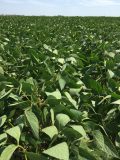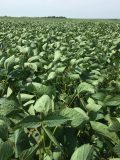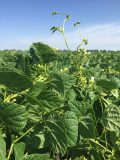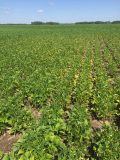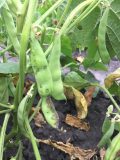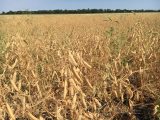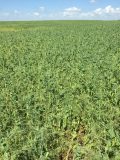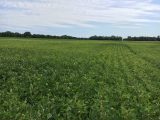August 7, 2019
- Crop Update
- Why are my soybeans turning yellow?
- Field pea harvest – desiccation timing and pre-harvest products
- Scouting for stem diseases
Listen to the Bean Report here:
Crop Update
Soybeans currently range from R4 (full pod) to R5 (beginning seed). Soybean crops appear to have caught up with one another across various regions of the province, resulting in a smaller range of development stages. It is expected that soybeans in the most advanced growing areas will reach the R6 (full seed) stage toward the end of the week. Monitor for spider mites, which have been reported in a few soybean crops. The risk of spider mite infestation is greater in hot, dry conditions and following previous insecticide application, meaning 2019 is a high-risk year.
Dry beans are mainly at R5 (beginning seed), with lower leaves beginning to senesce. Common bacterial blight symptoms are beginning to appear on pods. This disease first appears as small circular, water-soaked spots that enlarge and become surrounded by a reddish-brown border. No signs of white mould have been reported and risk remains low.
Field peas mainly range from R5 (beginning maturity) to R7 (full maturity), with crops rapidly changing in these dry conditions. A few pea fields were already harvested over the weekend. If you are planning to desiccate your peas, keep a close eye on development. Find more information on pea desiccation below.
Faba beans range from the R6 (beginning maturity) to R7 (mid-maturity) stages. Rain-fed faba beans are more advanced than irrigated crops under these dry conditions.

Many pulse and soybean crops across Manitoba are now under drought stress with the lack of rain. For these crops, it is the late July/early August rains that count the most for yield (i.e., pod and seed development). Areas with sandier soil are especially hit hard by these conditions. We may need to adjust our yield expectations if we don’t get more rain soon. Get out and do your rain dance!
Why are my soybeans turning yellow?
This is a question that has been asked by several farmers over the past couple of weeks who have found patches of soybeans in their fields turning yellow. We have observed that yellowing soybeans are mainly in low spots of the field. The answer is likely one or more of the following factors:
- Late-season iron deficiency chlorosis (IDC) – Heavy rains a few weeks ago likely brought soluble salts closer to the upper soil profile. Hot, dry evaporative conditions afterward left the salts behind, making soybeans susceptible to temporary iron deficiency again.
- Salinity – In addition to increasing the risk of IDC, soybeans and pulse crops do not like saline conditions in general. Saline conditions can stunt growth and turn plants yellow. Given the ongoing dry conditions, we are not surprised to see the impact of salinity across Manitoba.
- Nitrogen (N) deficiency – Some yellowing may be caused by N deficiency brought on by inadequate nodulation, loss of activity in nodules or loss of nodules. Under waterlogged conditions in field drains and depressions, N-fixation may be reduced, or nodules may slough off. There is also the possibility that dry conditions earlier on reduced the efficacy of inoculant products. Rescue options are available if this is the case in your field and the timing is right.
- Root rot – Plants may have become infected with Fusarium, Rhizoctonia or Phytophthora while the soil was wet. In these cases, you might see speckled yellowing of leaves and plants dying off from these diseases.
The best way to determine the exact cause(s) is to investigate affected areas and dig up roots.
Field Pea Harvest
Field Pea Desiccation Timing
- Optimal field pea desiccation timing is when seed moisture is < 30%
- What does 30% seed moisture look like in field peas?
- Lower 75% of pods are brown.
- Seeds are firm, rubbery and split when they are squeezed (R7-full maturity).
- Tops of plants may still be green and middle pods may be shrunken and leathery.
- How do you check your field?
- Examine 10 – 20 seeds from random plants across the field for splitting.
Field Pea Pre-Harvest Product Restrictions
- MPSG encourages farmers to refer to the Keep it Clean! MRL advisory ,our field pea maturity guide and to contact their buyer as a part of their pre-harvest application decision.
- It is good practice to consult with your exporter/processor before using pre-harvest glyphosate, diquat (Reglone), glufosinate (MPower Good Harvest), and/or flumioxazin (Valtera) or other pesticide products
- Why?
- MRLs may be established in key markets but are low in some countries.
- Certain products may not be accepted by local markets or processors (e.g., Roquette is not accepting peas desiccated with Reglone).
Scouting for stem diseases
Stem and root diseases can have a greater impact on soybean yield and quality than foliar diseases. Symptoms typically arrive later in the growing season during reproductive stages, which can directly impact pod and seed production. The most prevalent and economically important diseases in this category are white mould (Sclerotinia) and Phytophthora. However, there are a few others to keep an eye out for, including those that have not yet been confirmed in Manitoba.



